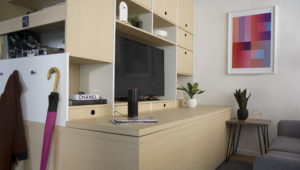Watching robotic furniture by Ori feels like getting a preview of the future. Tap your finger on a button and your bed hides away below cabinets. Or, out of a closet, comes a wooden desk table. Or, your entire office set-up or entertainment center tucks away from a room’s center to the wall.

But behind the seemingly magical system created by a crew of MIT-trained minds is a story as fascinating as the $15,000 Ori gadgets themselves.
BostInno recently spoke by phone with Ori’s founder and chief executive, Hasier Larrea, and over email to designer Yves Béhar, about the Hub-based company. Just about six months after raising $6 million in venture funding, Ori is now manufacturing the furniture systems, and the first batch of shipments is going out this month to furnish buildings in cities such as Miami, New York, and Boston -– including in the Continuum building in Allston.
A native of San Sebastian, Spain, Larrea talked about the direction of the company and its founding, while Behar, chief executive of California-based Fuseproject, which has partnered with Ori, discussed the furniture’s design.
BostInno: Where did the idea for Ori furniture come from?
Local
In-depth news coverage of the Greater Boston Area.
Larrea: It was a team effort. It started at MIT as research back in 2011 … with professor Kent Larson — who’s an architect — and a great team on engineers. We started exploring how we could merge the world of robotics with the world of architecture and furniture. … We thought there was some possibility of integrating them, especially … as cities like Boston and New York — and internationally, like London and Hong Kong — are just running out of space. We started thinking about how we could change the paradigm for space, how space could adapt to us, instead of us adapting to space.
BostInno: And then what?
Larrea: We built a prototype, and then around 2015, we decided to spin out a company….
BostInno: How much funding have you raised so far?
Lerrea: We started with a seed round out of MIT of about a million dollars … that allowed us to basically get a team together, get the first viable product ready and to create a pilot apartment in the Seaport, so that we could install our prototype. … We also partnered with Yves Béhar … to bring the product to the next level. Then, last year, around September, we raised … around $6 million. Our lead investor is Khosla Ventures.
BostInno: What did that funding do for Ori?
Larrea: It allowed us to launch production, which we basically did two weeks ago. … This week we are starting to install units around the country. Today we are installing systems in Miami.

BostInno: Behar, what appealed to you about Ori?
Behar: …The Ori team is addressing the livability of micro-apartments in urban centers…. I believe that urban density requires solutions such as the one the Ori team developed, for this reason I wanted to be part of the team…. Ori addresses this issue with technology, but also … it empowers people to live luxuriously with a smaller environmental footprint.
BostInno: What considerations did you take to make the furniture look good?
Behar: … For me it was important to make Ori feel more like a beautiful piece of furniture than a giant robot in our home. Soft neutral colors, natural materials like wood, and finish choices are important. Functionally providing a variety of uses is key, such as having an office desk, extra storage and lighting….. (And) it’s as simple to use as a light switch….
BostInno: Where is the furniture manufactured?
Larrea: Keep in mind that it’s very hard to find a manufacturer that specializes in both furniture and robotics. So, our supply is more complicated. …We are working with three manufacturers for three different parts of the product. …The actuator, a component that goes on the floor, is made in California; the furniture is made in Rhode Island; and the robotics and electronics are in Vermont. …Then the three packages that create the product are shipped to a city. Let’s say (we have an order) in San Francisco, we ship the packages to the city, and then we have a certified network of installers … and they assemble it in one day.
BostInno: As demand goes up, do expect another round of funding?
Larrea: It’s a little early to tell… depending on how this round rolls out, we will decide our strategy. We will wait and see how the next three to six months play out.
BostInno: Do you think you’ll get these to a cost at some point where normal people will be able to buy them for their condo or apartment?
Larrea: You’re right that most of these have been in more higher-end buildings. But … we look at it as you have the robotics on one side and you have the furniture on the other. And the biggest cost of this system is actually not the robotics, it’s the furniture. Furniture can be made as cheaply or expensively as you want….
Q: Where would you like to see Ori in five years from now?
Larrea: I want when people see Ori that they are not going to just think about that first product that they see…. We want people to look at Ori as this new way of powering space design…. We also want to open this up so (everyone from) freelance designers to big furniture companies can tap into this technology. … We see this more as an ecosystem for designing spaces rather than a one-up product.
BostInno: Are you looking forward to the day when you stay in a hotel in Madrid or somewhere and see these in the room?
Larrea: I would love to be in Madrid, or even Tokyo, to go to a hotel in Tokyo, and not only see that there is a robotic system, but one that I haven’t seen or haven’t imagined, but it’s powered by our technology. …
This interview was edited for length and clarity.



